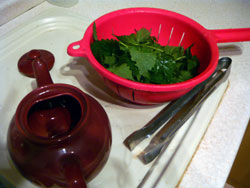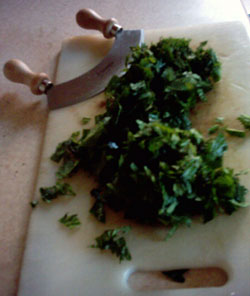And so our autumn experiment in wild food continues – with nettles. It’s all very well picking fruit, and almost a civic duty to collect blackberries, but when you venture into weeds – and aggressive ones to boot – that’s a whole new level of experimentation. But it’s an urge that won’t die, so we decide to give it a go.

We read around the subject and discover that, in contrast to wild mushrooms, it does seem to be remarkably hard to poison yourself with nettles, and furthermore that they are considered highly nutritious and a splendid addition to many everyday dishes such as soup, gnocchi and risotto. Overcoming some household reluctance towards eating something that tastes like spinach – given that spinach itself is no great favourite – the first thing to do is to identify a good venue for picking them.
We choose one of our local open spaces where there are plenty of plants in unregarded corners with new green shoots on them. The privacy to do this is important – everybody understands about blackberrying, but imagine explaining to a nosy passer-by how you’re going to stew up an invasive weed for your tea. Also, much of the point of making use of foodstuffs like this is negated if you need to drive miles to collect them. Local is very good for this project.
This area is managed with an eye to wildlife so people are unlikely to have been spraying pesticides about. As ever with foraging, plants are collected above knee-level to avoid any canine attentions they may have received. Although presumably it is a brave dog that cocks its leg in a nettle patch. Still, better safe than sorry. Also any plants that are obviously a home to wildlife should probably be left alone. And it’s important to take a few leaves from many plants spread over a wide area rather than heavily denuding one small patch of vegetation.

The advice we’ve read suggests using scissors to harvest the young tips and also advises avoiding the bitter larger leaves. We used latex gloves and arrived home only mildly stung. With two large carrier bags of nettle tips in hand we are left somewhat smugly contemplating the price of the same quantity of organic greenery when it comes in the veg box or off the supermarket shelf. We’ve no idea whether or not we’ll eat all this – but, if not, there’s always nettle fertiliser. That’s the smelly plant superfood that results when you put nettles in a bucket of water for a few weeks and leave them to rot. Drain off the pungent liquid and put a bit in your watering can and your prize dahlias and tomato plants will shoot up like nobody’s business.
And now to the first big test – nettle tea. We learn the plants can conflict with certain sorts of medication, act as an emetic and also potentially aggravate a delicate digestion so, like anything else, it’s a case of exercising common sense and only trying a little bit at first. So an infusion is our first experiment, one we survive in rude health. We find a recommendation that you start with no more than one cup of nettle tea a day when you first try it, in order not to give your system too much of a shock. We follow this very sensible advice and also choose not to drink the stuff on an empty stomach while it is still unfamiliar.

The infusion is very pale, possibly because we used approximately half the nettles we should, failed to chop them finely enough, and then added about twice the necessary water. However, flavoured with some mint leaves, a couple of drops of lemon juice and a little honey, we get a pleasant drink and put the excess in the fridge to consume when cold. Overnight it turns a dark tawny brown but is still pleasant and refreshing.
Now we can contemplate nettle cookery with a risotto and a soup recipe top of the list. The next job is to chop and wash another batch of our nettles and store them in the fridge until needed. This is done using gloves and a large knife to cut away the stalk sections – while these are said to be perfectly edible they won’t necessarily provide the most appetising forkful. After chopping them roughly in this way (a task that also required latex gloves) we chopped them more finely with a mezzaluna herb knife before drying and storing them.

As to what they taste like – well, that will be the subject of our next post. We hope…
Note to readers: If you’re thinking about trying cooked nettles or nettle infusion, you should be aware that this post chronicles our experiences as relative newcomers to foraging and wild food. We are not experts in this subject and you will need to consult further afield than this post for the all-important safety, collecting etiquette and preparation tips. Nevertheless, bearing that in mind, we hope you find our experiences both useful and enlightening.